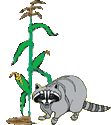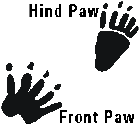





Raccoons And Ripe Corn / Deer At The Brook / Come Out, MuskratsLanguage: English | |
Jim Arnosky’s beautifully illustrated books provide the inspiration for LeVar to learn about wildlife watching. They team up for a day of exploration and playing detective. Viewers learn that teeth marks on twigs are a good sign that beavers are nearby. If they look closely on tree trunks, they might see tiny porcupine claw marks. Viewers will get a close look at raccoon paw prints and learn how to tell if they were drinking from the brook or just passing by. |
 |
Here are activities to do after watching this episode: |
||||

Raccoon Paw-Print Socks
You’re right! The raccoon has the same number of toes as you do! Use raccoon paw prints to make a special pair of socks. You will need:
|
How Much Does It Weigh?A raccoon is considered to be a medium-sized animal. An average raccoon weighs about 25 pounds. Get out the family scale and find five things— people or pets —that weigh less, and five that weigh more than a raccoon. Animal TalesAsk you child what makes the raccoon such a unique animal. The answer will probably be the “mask” of dark fur across the raccoon’s face. Its striped tail is quite neat, too! The Native American word for raccoon is “arakunem (ah-rah-KOO-nem). The name eventually was shortened to “raccoon.” Have your child make up a tale telling how the arakunem or raccoon got its mask and striped tail. You may enjoy reading together other animal legends that explain animal characteristics. |
|||
|
||||
READING RAINBOW has a resource library that includes teacher guide materials as well as reading programs for use in the public libraries. You can download these resources from GPN at:
www.gpnresources.com
If you would like more information about READING RAINBOW or if you would like to learn more about other educational products please visit the GPN web site.